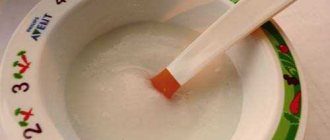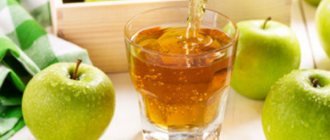Every mother dreams of diversifying children's menu. At 5 months Pediatricians recommend adding porridge to the vegetable and fruit purees already introduced into complementary foods. Porridges are very nutritious, which means that the growing baby will receive more energy for his important daily activities - after all, he has so much to master and learn so much! The basis of a toddler’s diet is still breast milk or its substitute, and therefore porridges may well be milk-based - perhaps this will make it easier for the baby to try new dishes.
Is it possible to start feeding at 5 months?
Pediatricians are of the same opinion and call the time to start complementary feeding – six months. With a sufficient amount of breast milk and its high calorie content, the baby has enough nutrition, he can easily do without complementary feeding for up to 6 months. Dr. Komarovsky also insists on this breastfeeding regimen, considering breast milk to be the best product for babies. In addition, according to Komarovsky’s deep conviction, in order to keep a child on breast milk for up to 6 months without complementary feeding, the mother needs to eat well.
Complementary feeding at 5 months is justified and really necessary for bottle-fed babies and those who clearly do not have enough mother’s milk. If the baby is not gaining weight well and is lagging behind the norm in growth, the cause may be insufficient nutritional value of the mother’s milk (for more details, see the article: why does a child gain weight poorly and does not want to eat?).
What signs determine a baby’s readiness for complementary feeding?
The age recommended by experts at 6 months for the first complementary feeding is an average figure. The development of each small organism takes place according to an individual plan, both in the sphere of the psyche and in the field of internal organs. It is obvious that the needs of children of the same age differ. Some signs will help you determine that your baby is ready for complementary feeding:
- The baby's weight has doubled since birth. The premature baby gained 2.5 times his weight.
- The ejection reflex has disappeared, when the baby’s tongue reflexively pushes out objects that fall into the mouth, playing the role of a protector. If you introduce complementary foods before this reflex goes away, the toddler will not be able to swallow food.
- A confident “sitting” position when your treasure sits down without falling over or swaying.
- The baby clearly does not have enough of his usual food, he diligently sucks the boob, after drinking a bottle of formula, asks for more, cries, feeling hungry.
- The child turns away from the food in the spoon, showing his parents that he does not want to eat now.
- Eruption of the first teeth.
- Increased interest in the food that mother eats. The toddler may try to take a piece from his mother's plate.
Teething is a sign that the baby is ready to introduce complementary foods.
It would be wrong to talk about the presence of all signs, because children begin to sit at different ages, and everyone’s teeth grow differently. It is clear that you need to monitor the overall development of your treasure and not delay the introduction of complementary foods if you do not find all the described signs in him. A mother's heart and constant monitoring of the baby will tell you when the time has come to introduce complementary foods.
What foods can you feed?
Breastfeeding or formula milk is the main food for a baby at 5 months. When preparing a 5-month-old child for complementary feeding, you should gradually introduce him to new foods without forcing the transition to adult food. Any pediatrician will tell you that you need to introduce new foods in small portions. In addition, the choice of products should be careful and competent. What is suitable for feeding a 5-month-old baby? Experts unanimously agree on porridge without milk and vegetable purees.
However, Dr. Komarovsky, known to us, advises starting to feed the baby with fermented milk products. The famous pediatrician argues for his proposals by the fact that most fermented milk dishes are as close in composition as possible to breast milk and formulas. Komarovsky considers an important factor in favor of fermented milk food to be the ability of fermented milk bacteria to suppress various intestinal infections and destroy harmful microbes.
How to start the first feeding?
Based on the above signs and having received the go-ahead from the pediatrician, parents need to competently organize the child’s introduction to unusual foods. Remember the following rules:
- introduce a new product only when your baby is absolutely healthy;
- You cannot start complementary feeding if vaccination is planned or the vaccination was done the day before;
- serve only freshly prepared food;
- create a menu using one-component compositions;
- the consistency of the dish should be homogeneous and semi-liquid;
- The first complementary foods should be introduced in the morning feeding in order to monitor the reaction of the baby’s body (we recommend reading: at what age should you start introducing complementary foods when artificial feeding?);
- the amount of the new product should not exceed 1 teaspoon;
- Having introduced your child to one product, introduce the next one no earlier than a week after the first.
Complementary feeding will become complete nutrition when a single serving reaches a size of 100-150 grams; until then, the mother should continue to feed the baby with milk or formula. The table will help you avoid mistakes:
| Products | Quantity per day |
| Breast milk | 800 ml |
| Fruit purees | 45 grams |
| Vegetable puree | 130 grams |
| One-component cereals | 50 grams |
| Vegetable oil | 3 grams |
| Butter | 3 grams |
The portion of complementary foods should be increased, gradually bringing it to normal
The benefits of complementary feeding
Complementary feeding is any food other than breast milk or formula. Additional nutrition is important for the proper development of the baby’s body and saturation with the missing nutritional components.
Complementary feeding provides:
- enrichment of the diet with microelements;
- supplementing nutrition with vitamins;
- additional energy reserve for vigorous activity.
Microelements necessary for active development contribute to the development of not only the baby’s physical abilities, but also his mental abilities. However, complementary foods should not replace formula or breast milk.
Optimal complementary feeding scheme
The scheme for introducing new food is the same for all foods and ages. Only one new product can be given to the baby at one feeding. Pediatricians recommend feeding children meals from one group: porridge or vegetables. When your baby begins to eat a full portion of dishes from the first group, you can move on to feeding dishes from the second group. The step-by-step feeding scheme is as follows:
- A serving of 1 teaspoon of liquid porridge or puree is given to the baby at the beginning of the morning feeding, then the baby receives regular food (breast milk or formula).
- The next morning feeding begins with two teaspoons of complementary foods, if the baby’s body has positively accepted the new product during the day.
- The child is fed one product all week, doubling the portion at each morning feeding.
- Having brought the quantity to a full portion, you can move on to another product, which should be given in the same proportions as the first.
- When the child is a little accustomed to unfamiliar food, you can introduce it into the second feeding.
- When doubling the portion of a new product, you need to halve the amount of an already familiar dish.
- Make the transition from one product to another when the baby eats the full portion of the previous dish. After a while, when the child is quite accustomed to “adult” food, you can give him multi-ingredient dishes.
A new dish is introduced after the previous one has been fully mastered
Rules for introducing complementary foods
- Graduality and dosage. A 5-month-old baby should receive complementary foods little by little; he still needs to get used to new food.
- The right time. In order not to miss an alarming reaction, complementary foods should be given to a 5-month-old baby in the morning or evening feeding.
- Using a spoon. “Adult” food should be served with “adult” cutlery - this is convenient and makes it easier to measure portions.
- Temperature and consistency. For a child familiar only with breast milk, it is important that the food is liquid and warm (36-37 degrees).
And, perhaps, the main rule is to make sure that the child is healthy. Conditions for monitoring reactions to new foods must be ideal - if your baby has been vaccinated, wait at least a week.
Vegetables for first feeding
Experts recommend starting complementary feeding with vegetable purees. Vegetables contain a lot of useful substances and have a beneficial effect on the functioning of children's digestion. Use vegetables such as carrots, zucchini, and various types of cabbage, except white cabbage. How to properly introduce vegetable purees into your baby’s diet:
- When choosing ready-made purees in jars, give preference to single-component homogenized types.
- Take a teaspoon of puree, heat it a little until warm and give it to your baby before morning feeding. If your child tries the puree and immediately spits it out, don’t worry, the baby needs time to get used to the unusual food. Keep trying every morning by supplementing with breast milk or formula.
- If the little one ate the food offered to him without any whims, double the portion for the next feeding. The serving breakdown for each day is as follows: 1,2,4,8 teaspoons. When their number reaches 150 grams, one feeding can be carried out only with vegetable puree.
- Having mastered one vegetable with your baby, move on to getting to know another fruit. Remember that the introduction of a new fruit should take place no earlier than 2 weeks after the first product. Increase the serving size gradually.
Dishes
Get your baby a set of his own dishes. Of course, it’s too early to offer him a fork, but his own set of plates, a drinking cup and spoons will be very useful. It is best to choose dishes with a bright design so that it evokes pleasant emotions in the baby. Sometimes mothers boast that they give soup or thin porridge from a bottle - this should not be done. It is better to teach your child to eat with cutlery from an early age.
For each feeding, two spoons are needed - the mother feeds the baby with one, and he holds the second in his hands. Over time, you will notice that the child tries to take food on his own. Even if some part of it ends up on the floor or table, it’s okay; over time, your daughter or son will get used to eating carefully, without scattering food all over the dining room.
What porridges are suitable for babies?
Porridges are recommended for babies who are not gaining weight well. The ready-made porridges offered in stores contain sugar and are very popular with infants. Many little ones eat them with pleasure, but there is some danger hidden in such adoration. Having tasted the yummy food, the baby may refuse to eat bland vegetable puree, which is just as necessary for him as porridge. For this reason, pediatricians advise first introducing children to vegetables, and only then accustoming them to cereals.
Technically, feeding cereals looks the same as feeding vegetables. For starters, choose gluten-free grains. This protein can cause disturbances in the child’s digestion, including pain.
For a 5-month-old baby, cereals such as buckwheat, rice, and corn are suitable. Oatmeal and semolina porridge are offered to children to try from 8-9 months.
The new diet excludes the introduction of cereals made with milk. The fact is that milk contains amylase, but the baby has not yet developed enzymes capable of breaking it down. Milk porridge is given at the age of 7-8 months (more details in the article: when are milk porridges introduced for children?). Industrially prepared porridges rich in essential ingredients will help ensure a balanced diet. Porridge for babies should be:
- warm and liquid;
- better without sugar;
- served in sterile containers and from a spoon;
- portions equal to 1-2 teaspoons, with gradual increase;
- It is better to feed porridge before bedtime so that the child is full and sleeps deeply, Dr. Komarovsky also insists on this.
Your child's first cereal should be dairy-free.
What kind of porridge can be given at 4 and 5 months?
The information below is suitable for a child of any age if you decide to give this product for the first time.
It is recommended to start with dairy-free cereals, both gluten-free and single-ingredient. What does it mean?
Gluten-free cereals, that is, those that do not contain gluten, are, for example, buckwheat, rice and corn.
A one-component dish is a dish made from one main component, that is, either buckwheat, rice, or corn.
Dairy-free porridge - with water.
Bottom line
For the first complementary foods, you should choose buckwheat, rice, or corn dairy-free porridge. Moreover, it is necessary to remember that rice porridge strengthens, so it is not recommended to give it to children prone to constipation, but buckwheat, on the contrary, improves stool.
Can I have fruit puree?
Our grandmothers remember their youth, when they fed their babies fruit purees, and they felt great. Many pediatricians, including Komarovsky, disagree with them. Baby nutrition experts warn that fruits are not advisable as the first new food for babies 5-6 months old. Such recommendations are related to the fact that puree is made from raw fruits. A breastfed or bottle-fed baby is accustomed to milk or formula; his stomach is not yet prepared to digest raw foods. Fermented milk products, cereals and vegetable purees provide such preparation.
Is it acceptable to feed a 5-month-old baby soups with meat broth?
This question is often asked on women's forums. And although the temptation to cook your child with meat broth as early as possible is great, it is better not to do this. Even tender veal or turkey meat will put a serious strain on the baby’s digestive system - it is not yet ready to process these products. Vegetable purees and soups are much easier to digest, and children eat them with pleasure.
It takes at least three weeks to introduce each new product. If you decide to add beets or, for example, carrots to vegetable soup, then you will have to observe the child’s reaction for 20–21 days. If a rash on your cheeks or an upset stomach suddenly appears, you should return to your usual menu. You can often notice undigested food residues in your baby's stool - during the period of adaptation to new foods, this is a completely normal phenomenon. You should be concerned when diarrhea appears - in this case, you should urgently consult a doctor who will prescribe appropriate treatment.
What does Dr. Komarovsky advise?
Our favorite children's TV doctor, Komarovsky, believes that the first dishes that should be introduced to an infant at 5-6 months should be from a range of fermented milk products. Kefir, cottage cheese, homemade yoghurts are close to the composition of mother’s milk and are well absorbed by the baby’s body. The only requirement for such products is based on their calorie content. A well-known pediatrician advises choosing low-fat dishes that are prepared in specialized dairy kitchens.
In addition, the doctor confidently states that starting complementary feeding with fermented milk foods will help children’s digestion quickly and easily get used to the new menu. An important argument in favor of cottage cheese and kefir is the fact that they contain fermented milk bacteria, which promote the development of microflora in the intestines and help the rapid absorption of food. If your treasure is mixed-fed, his pancreas is under increased stress due to the processing of both milk and formula. Fermented milk food is perfect for such a baby as an initial addition to the menu.
According to Dr. Komarovsky, fermented milk products are excellent for complementary feeding
Scheme according to Komarovsky
In addition to useful advice, Dr. Komarovsky also developed his own scheme. We invite you to familiarize yourself with the description of the daily regimen:
- First day. We give the child 2-3 teaspoons of warm kefir before the second morning feeding, supplemented with milk or formula.
- Second day. We double the portion and feed again with the usual food.
- The third day. We increase the volume of complementary foods to 40-60 ml, give it from a spoon.
- Fourth day. Add some variety and add 1-2 teaspoons of cottage cheese to the kefir. We make sure to monitor the baby’s body’s perception of new food and pay attention to the consistency of the stool.
- Fifth day. We increase the portion of cottage cheese to 30 grams, leaving the amount of kefir the same. If the baby is not full, supplement him with breastfeeding or formula.
- Sixth and seventh days. The amount of fermented milk food a child receives in one feeding reaches 150-180 ml, which corresponds to one full serving of food. We are expanding the number of replacements and gradually introducing a new product for one more feeding per day. Following the instructions of the complementary feeding table, we continue to change the child’s menu, which in a few months will be completely transformed.
Having found out that we cannot do without complementary feeding, and that it is very important for babies, we looked at its various types. If there is a need to give the child new products, parents must provide them, even if the baby is less than six months old. The choice of products for the first complementary feeding is made by parents, but only after consultation with a pediatrician. Take into account all the recommendations and focus on the body of your treasure.
Pediatrician of the 2nd category, allergist-immunologist, graduated from the Belarusian State Medical University of the Federal Agency for Health and Social Development. Read more »










